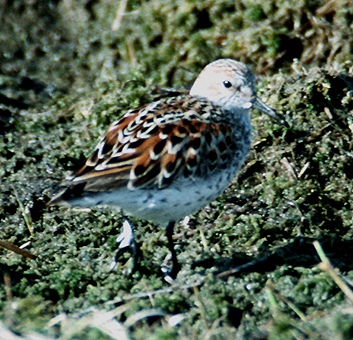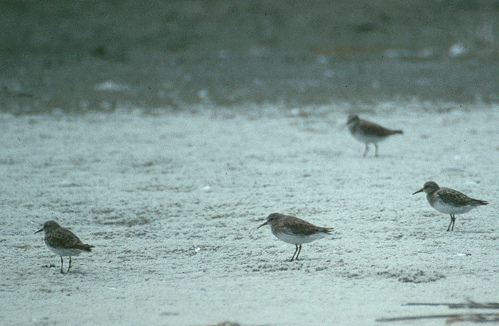|
Western Sandpiper Calidris mauri Playero Occidental
|
 |
|
Photo: G. Beaton
|
|
Western Sandpiper Calidris mauri Playero Occidental
|
 |
|
Photo: G. Beaton
|
|
IDENTIFICATION: A small shorebird with dark legs, and a proportionately longer bill than other small sandpipers. The bill sometimes has a drooped tip. In breeding plumage, has rusty flecks on its back and "shoulder" feathers, but in winter plumage, it can be difficult to distinguish from the Semipalmated Sandpiper. Length:14-17 cm.; weight: 22-36 g. VOICE: The call is a loud "chir-eep." Audio (M. Oberle). HABITAT: Breeds in the Arctic tundra of Alaska, and forages on exposed tidal marshes and salt flats in migration. HABITS: The Western Sandpiper travels in flocks, busily following the tide in search of insect larvae (flies and beetles), worms, small molluscs and other invertebrates. When resting, birds will often stand on one leg, giving the misleading impression that they are injured (see photo). On the Alaskan breeding grounds, the male establishes a territory often on the same patch of tundra occupied the previous year. The pair maintains a monogamous pair bond, and reinforces the bond by preening each other. Both sexes build a nest under dwarf shrubs near water and alternate incubating the four eggs for 20-22 days. The young leave the nest within hours of hatching, and both parents protect and brood the young for 19-21 days until the young can fly. The adults then migrate south, while the juveniles migrate several weeks later. In the Arctic, bird species that nest in the short summers at high latitudes have a narrow window for breeding. If a pair’s nest fails due to predation or other reasons, the adults usually head south and abandon any attempt to nest that year. There is some evidence that females winter farther south than males; most of the birds in one study in the West Indies were females. In the spring migration north, this species congregates to fuel up for several days at huge stopover congregations at Grays Harbor, Washington, and elsewhere. As many as 6,500,000---most of the world’s population--- pass through Alaska’s Copper River Delta each spring. STATUS AND CONSERVATION: A common winter visitor and migrant. Because such a large proportion of the species passes through a few strategic "stopover" locations on migration, these wetlands need special protection. RANGE: Breeds on tundra along the Arctic and Bering Sea coasts of Alaska, and the far eastern tip of Siberia. It winters on the Pacific coast mostly from California to Peru, and on the Atlantic coast from New Jersey to Surinam and the West Indies. A regular location to find this species is along tidal inlets at Cabo Rojo. TAXONOMY: CHARADRIIFORMES; SCOLOPACIDAE; Scolopacinae |
|
 |
|
Photo: G. Beaton
|
 |
|
|
Photo: G. Beaton
|
|
References Bent, A.C. 1927. Life histories of North American shore birds, part 1. Smithsonian Instit. U.S. National Museum Bull. 142. (Reprinted by Dover Press, NY, 1962). Borowik, O. A. and D. A. McLennan. 1999. Phylogenetic patterns of parental care in calidridine sandpipers. Auk 116(4):1107-1117. Collazo, J.A., B.A. Harrington, J. Grear, and J.A. Colón. 1995. Abundance and distribution of shorebirds at the Cabo Rojo salt flats, Puerto Rico. J. Field Ornithol. 66:424-438. del Hoyo, J., A. Elliott, and J. Sargatal, eds. 1996. Handbook of Birds of the World, Vol. 3. Hoatzin to Auks. Lynx Edicions, Barcelona. Grear, J. and Collazo, J. A. 1999. Habitat use by migrant shorebirds in a tropical salt flat system. Vida Silvestre Neotropical 7(1):15-22. Guglielmo , C. G., P. D. O'Hara, and T. D. Williams. 2002. Extrinsic and intrinsic sources of variation in plasma lipid metabolites of free-living Western Sandpipers (Calidris mauri). Auk 119(2):437-445. Hayman, P., J. Marchant, and T. Prater. 1986. Shorebirds: an identification guide. Houghton Mifflin, Boston. Paulson, D. 1993. Shorebirds of the Pacific Northwest. Univ Washington, Seattle. Raffaele, H.A. 1989. A guide to the birds of Puerto Rico and the Virgin Islands. Princeton. Raffaele, H.A. 1989. Una guía a las aves de Puerto Rico y las Islas Vírgenes. Publishing Resources, Inc., Santurce, PR. Raffaele, H.A., J.W. Wiley, O.H. Garrido, A.R. Keith, and J.I. Raffaele. 1998. Guide to the birds of the West Indies. Princeton. Saliva, J.E. 1994. Vieques y su fauna: Vieques wildlife manual. U.S. Fish & Wildlife Service, Boquerón, PR. Tripp, K. J. and J.A. Collazo. 1997. Non-breeding territoriality of Semipalmated Sandpipers. Wilson Bull. 109:630-642. Veit, R.R. and L. Jonsson. 1984. Field identification of the smaller sandpipers within the genus Calidris. American Birds 38(5):853-876. Wilson, W. H. 1994. Western Sandpiper (Calidris mauri). No. 90 in The birds of North America (A. Poole and F. Gill, eds.). Acad. Nat. Sci., Philadelphia, PA, and Am. Ornithol. Union, Washington, D.C. Wunderle, J.M., Jr., R.B. Waide, and J. Fernández. 1989. Seasonal abundance of shorebirds in the Jobos estuary in southern Puerto Rico. J. Field Ornithol. 60:329-339. Western Sandpiper, Spanish text Next related species in taxonomic order Previous related species in taxonomic order |
|